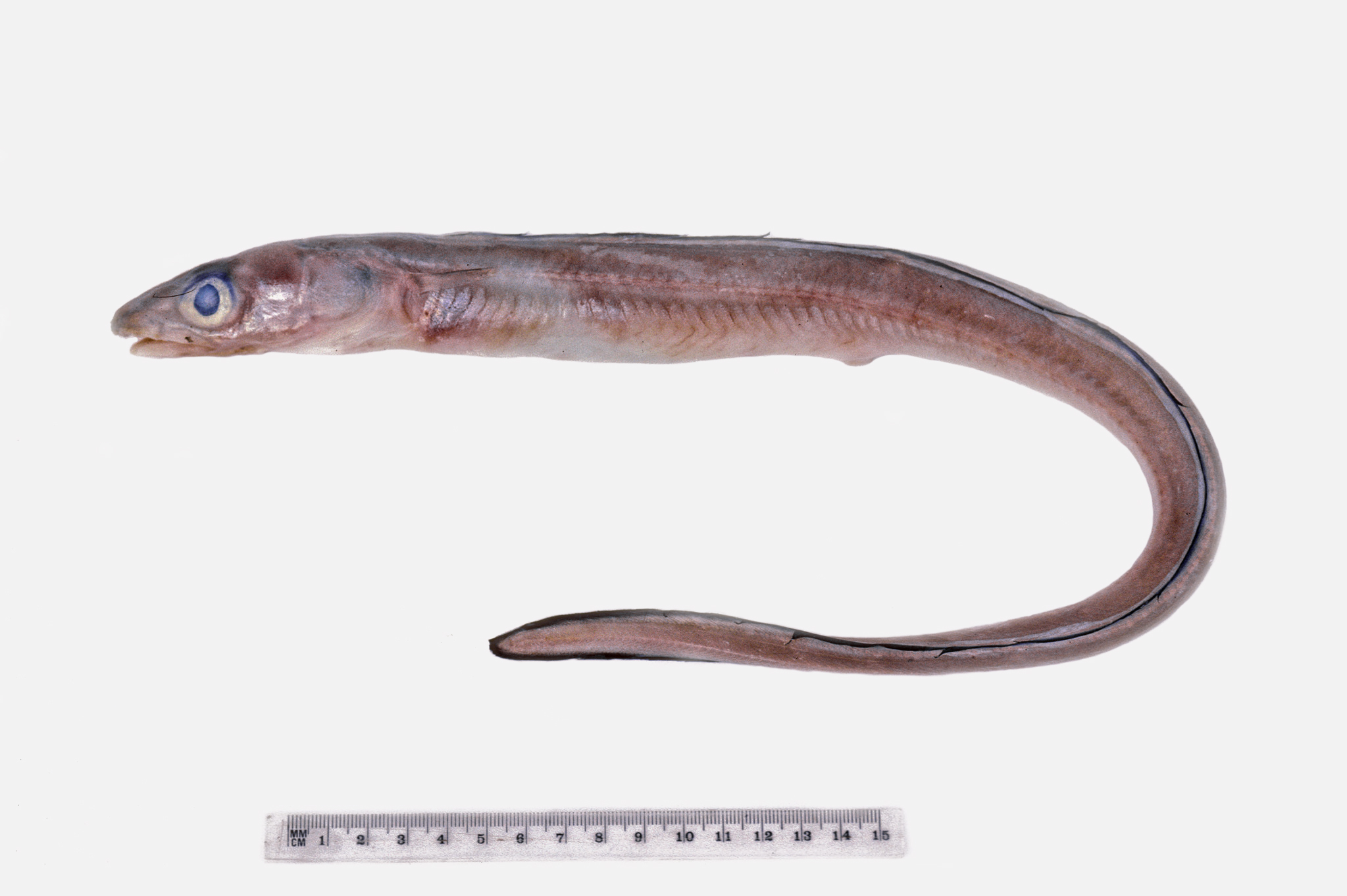- Classification
- ACTINOPTERYGII
- ANGUILLIFORMES
- CONGRIDAE
- Gnathophis
- umbrellabius
Umbrella Conger, Gnathophis umbrellabius (Whitley 1948)
Other Names: Fringe-nosed Conger-eel

An Umbrella Conger, Gnathophis umbrellabia, AMS I.29733-001, from south of Cronulla, New South Wales, depth 124-132 m, May 1985. Source: Ken Graham / iNaturalist.org. License: CC by Attribution-NonCommercial
Cite this page as:
Bray, D.J. 2022, Gnathophis umbrellabius in Fishes of Australia, accessed 03 Jul 2025, https://fishesofaustralia.net.au/Home/species/3912
Umbrella Conger, Gnathophis umbrellabius (Whitley 1948)
More Info
|
Distribution |
Off Forster, New South Wales, around southern Australia, to west of Leeman, Western Australia, including off Tasmania; also Norfolk Island in the Tasman Sea (and possibly Lord Howe Island). Elsewhere the species occurs in New Caledonia and New Zealand (including the Kermadec Islands). Inhabits silty, muddy and sandy areas on the Continental Shelf and Upper Slope. |
|
Feeding |
Feeds on small crustaceans and polychaetes at night. |
|
Biology |
Spawning occurs off shore during early winter and the larvae disperse along coasts during a pelagic larval stage of 10 months. |
|
Etymology |
The specific name umbrellabius is from the Latin umbrella (= umbrella) and labia (= lip), in reference to the umbrella like protrusions on the upper lip. |
|
Species Citation |
Fimbriceps umbrellabia Whitley 1948, Records of the Australian Museum 22(1): 70, fig. 1. Type locality: 3 miles off Broughton Island, New South Wales. |
|
Author |
Bray, D.J. 2022 |
|
Resources |
Umbrella Conger, Gnathophis umbrellabius (Whitley 1948)
References
Castle, P.H.J. 1963. The systematics, development and distribution of two eels of the genus Gnathophis (Congridae) in Australasian waters. Zoological Publications of the Victoria University, Wellington (34): 15-47 figs 1-10 (described as Gnathophis incognitus, type locality Kaikoura coast, New Zealand, 40-50 fathoms).
Castle, P.H.J. 1977. The congrid genus Fimbriceps, a synonym of Gnathophis. Copeia 1977(3): 581-582
Castle, P.H.J. 1994. Families Serrivomeridae, Muraenidae, Nemichthyidae, Congridae. pp. 205-215 figs 182-191 in Gomon, M.F., Glover, C.J.M. & Kuiter, R.H. (eds). The Fishes of Australia's South Coast. Adelaide : State Printer 992 pp. 810 figs.
Castle, P.H.J. & Robertson, D.A. 1974. Early life history of the congrid eels Gnathophis incognitus in New Zealand waters. New Zealand Journal of Marine and Freshwater Research 8(1): 95-110 figs 1-7 (as Gnathophis incognitus) See ref online
Francis, M. 1993. Checklist of the coastal fishes of Lord Howe, Norfolk, and Kermadec Islands, southwest Pacific Ocean. Pacific Science 47(2): 136-170 figs 1-2
Fricke, R., Kulbicki, M. & Wantiez, L. 2011. Checklist of the fishes of New Caledonia, and their distribution in the Southwest Pacific Ocean (Pisces). Stuttgarter Beiträge zur Naturkunde. Serie A (Biologie) Neue Serie 4: 341-463
Karmovskaya, E.S. & Paxton, J.P. 2000. Revision of the Australian congrid eels of the genus Gnathophis (Family Congridae), with descriptions of six new species. Journal of Ichthyology 40(Suppl. 1): 1-14
Smith, D.G. 2008. Family Congridae. pp. 174-179 in Gomon, M.F., Bray, D.J. & Kuiter, R.H. (eds). Fishes of Australia's Southern Coast. Sydney : Reed New Holland 928 pp.
Smith, D.G. & Stewart, A.L. 2015. Families Derichthyidae, Nemichthyidae, Congridae, Nettastomatidae, Serrivomeridae. pp. 259-290 in Roberts, C.D., Stewart, A.L. & Struthers, C.D. The Fishes of New Zealand. Wellington : Te Papa Press Vol. 2 pp. 1-576.
Taylor, R.B. & Morrison, A. 2008. Soft‐sediment habitats and fauna of Omaha Bay, northeastern New Zealand. Journal of the Royal Society of New Zealand 38(3): 187-214.
Tighe, K., Smith, D.G. & McCosker, J. 2019. Gnathophis umbrellabius. The IUCN Red List of Threatened Species 2019: e.T199172A2566392. https://dx.doi.org/10.2305/IUCN.UK.2019-1.RLTS.T199172A2566392.en. Accessed on 27 September 2022.
Whitley, G.P. 1946. Australian marine eels. The Australian Museum Magazine 9(2): 60–65 11 figs p. 6 (figure and name only, no description)
Whitley, G.P. 1948. Studies in Ichthyology No. 13. Records of the Australian Museum 22(1): 70-94 figs 1-11 https://doi.org.10.3853/j.0067-1975.22.1948.592




